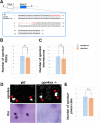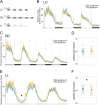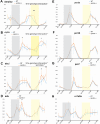Contribution of the eye and of opn4xa function to circadian photoentrainment in the diurnal zebrafish
- PMID: 38408087
- PMCID: PMC10919856
- DOI: 10.1371/journal.pgen.1011172
Contribution of the eye and of opn4xa function to circadian photoentrainment in the diurnal zebrafish
Abstract
The eye is instrumental for controlling circadian rhythms in mice and human. Here, we address the conservation of this function in the zebrafish, a diurnal vertebrate. Using lakritz (lak) mutant larvae, which lack retinal ganglion cells (RGCs), we show that while a functional eye contributes to masking, it is largely dispensable for the establishment of circadian rhythms of locomotor activity. Furthermore, the eye is dispensable for the induction of a phase delay following a pulse of white light at CT 16 but contributes to the induction of a phase advance upon a pulse of white light at CT21. Melanopsin photopigments are important mediators of photoentrainment, as shown in nocturnal mammals. One of the zebrafish melanopsin genes, opn4xa, is expressed in RGCs but also in photosensitive projection neurons in the pineal gland. Pineal opn4xa+ projection neurons function in a LIGHT ON manner in contrast to other projection neurons which function in a LIGHT OFF mode. We generated an opn4xa mutant in which the pineal LIGHT ON response is impaired. This mutation has no effect on masking and circadian rhythms of locomotor activity, or for the induction of phase shifts, but slightly modifies period length when larvae are subjected to constant light. Finally, analysis of opn4xa;lak double mutant larvae did not reveal redundancy between the function of the eye and opn4xa in the pineal for the control of phase shifts after light pulses. Our results support the idea that the eye is not the sole mediator of light influences on circadian rhythms of locomotor activity and highlight differences in the circadian system and photoentrainment of behaviour between different animal models.
Copyright: © 2024 Chaigne et al. This is an open access article distributed under the terms of the Creative Commons Attribution License, which permits unrestricted use, distribution, and reproduction in any medium, provided the original author and source are credited.
Conflict of interest statement
The authors have declared that no competing interests exist.
Figures








Similar articles
-
Unexpected diversity and photoperiod dependence of the zebrafish melanopsin system.PLoS One. 2011;6(9):e25111. doi: 10.1371/journal.pone.0025111. Epub 2011 Sep 22. PLoS One. 2011. PMID: 21966429 Free PMC article.
-
Circadian rhythms in the pineal organ persist in zebrafish larvae that lack ventral brain.BMC Neurosci. 2011 Jan 13;12:7. doi: 10.1186/1471-2202-12-7. BMC Neurosci. 2011. PMID: 21232144 Free PMC article.
-
Functional heterogeneity in the pineal projection neurons of zebrafish.Mol Cell Neurosci. 2020 Mar;103:103468. doi: 10.1016/j.mcn.2020.103468. Epub 2020 Feb 3. Mol Cell Neurosci. 2020. PMID: 32027966
-
Circadian photoreception in vertebrates.Cold Spring Harb Symp Quant Biol. 2007;72:499-508. doi: 10.1101/sqb.2007.72.003. Cold Spring Harb Symp Quant Biol. 2007. PMID: 18419310 Review.
-
The evolution of irradiance detection: melanopsin and the non-visual opsins.Philos Trans R Soc Lond B Biol Sci. 2009 Oct 12;364(1531):2849-65. doi: 10.1098/rstb.2009.0050. Philos Trans R Soc Lond B Biol Sci. 2009. PMID: 19720649 Free PMC article. Review.
Cited by
-
Melanopsin in the human and chicken choroid.Exp Eye Res. 2024 Oct;247:110053. doi: 10.1016/j.exer.2024.110053. Epub 2024 Aug 14. Exp Eye Res. 2024. PMID: 39151779 Free PMC article.
References
-
- Bhadra B, N T, P D, M PB. Sleep medicine. 2017 [cited 2021 Oct 18]. Evolution of circadian rhythms: from bacteria to human. Available from: https://pubmed-ncbi-nlm-nih-gov.insb.bib.cnrs.fr/28619182/ - PubMed
-
- Freedman MS, Lucas RJ, Soni B, Schantz M von, Muñoz M, David-Gray Z, et al.. Regulation of Mammalian Circadian Behavior by Non-rod, Non-cone, Ocular Photoreceptors. Science [Internet]. 1999. Apr 16 [cited 2021 Oct 18]; Available from: https://www.science.org/doi/abs/10.1126/science.284.5413.502. - DOI - PubMed
MeSH terms
Substances
LinkOut - more resources
Full Text Sources
Molecular Biology Databases
Miscellaneous

